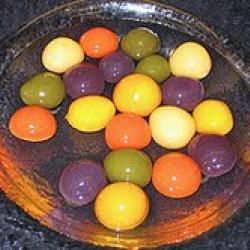Source Institutions
Source Institutions
Add to list Go to activity
Activity link broken? See if it's at the internet archive

Learners add drops of alginate solution to a solution of calcium chloride. The alginate does not mix with the calcium chloride, but forms soft gel beads. After rinsing off the beads, learners are invited to touch the beads and investigate their texture. Learners discover that alginate (made from seaweed) is often added to food products (ice cream, chicken nuggets) to improve texture. Learners can experiment with different variables: leaving drops in the calcium chloride for different amounts of time, adding different amounts of alginate solution, pouring calcium chloride over a shape of alginate solution in a petri dish. This activity is currently used in the Biochemistry Unit in OMSI's Chemistry Lab. Cost estimates are per 100 learners.
- 30 to 45 minutes
- 5 to 10 minutes
- per group of students
- Ages 8 - adult
- Activity, Experiment/Lab Activity
- English
Quick Guide
Materials List (per group of students)
- One petri dish
- One 25-ml graduated cylinders
- One 50-ml plastic beaker
- One 60-ml dropper bottle
- Two 250-ml squirt bottle
- 2 ml spoon
- 2 L jug
- Large plastic bucket type container
- Experiment copy
- 15% CaCl2 solution
- Dry alginate (keep 250 g on hand)
Subjects
-
Life Sciences
-
Human Senses and Perception
- Taste
-
Human Senses and Perception
-
Physical Sciences
-
Chemistry
- Chemical Reactions
- States of Matter
-
Chemistry
Informal Categories
- Food and Cooking
- Science Festivals Activity
Audience
To use this activity, learners need to:
- see
- read
- touch
Learning styles supported:
- Involves hands-on or lab activities
Other
Components that are part of this resource:
This resource is part of:
Access Rights:
- Free access
By:
Rights:
- All rights reserved, Oregon Museum of Science and Industry, 1997
Funding Source:
- National Science Foundation
